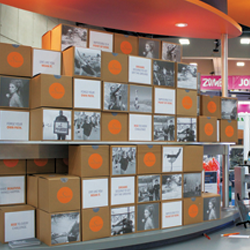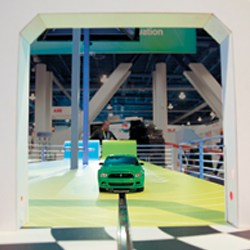|
sizzle awards
photos: Exposures Ltd.
Ground Rules!
To generate awareness for its natural products and soil-regeneration initiatives, General Mills Inc. breaks ground on an educational exhibit strategy that helps it harvest 200 percent more media articles than marketers hoped. By Linda Armstrong
Integrated Program
Exhibitor: General Mills Inc.
Creative/Production: Nparallel LLC, Minneapolis, 763-231-4800, www.nparallel.com Show: Natural Products Expo West, 2019 Promotional Budget: $100,000 – $199,000 Goals: • Distribute 10,000 product samples. • Generate 10 articles about the company's soil-regeneration efforts. • Earn a best booth mention from industry influencer Max Goldberg. Results: • Gave out 11,000 samples. • Scored 30 pieces of press coverage and 1.4 billion unique monthly visitors. • Made Goldberg's best booths list.
When it comes to General Mills Inc., people often associate it with brands such as Cheerios, Betty Crocker, and Pillsbury – and descriptors like "packaged foods" and "multinational conglomerate." Words such as "social-responsibility initiatives" and "organic offerings" probably aren't top of mind when pondering the Big G. Yet as evidenced by the company's recent actions and acquisitions, it seems to be dipping its big ol' toe into the lucrative natural-foods market, a move that's likely to attach more health- and environment-conscious connotations to the brand.
Starting back in 2000, General Mills began cultivating a stake in the natural-food-products industry with the acquisition of Small Planet Foods Inc., purveyor of Cascadian Farm and Muir Glen brands. In the ensuing years, it also gobbled up similarly healthy and environmentally aware brands such as Lärabar, Mountain High Yoghurt, Food Should Taste Good, Liberté, Immaculate Baking, Annie's, and Epic. But the company didn't just eat and run, so to speak. It also took big steps to upsize its social-responsibility efforts. Although it had previously established a multitude of initiatives covering food safety, human rights, planetary issues, and more, on March 4, 2019, it issued a press release pledging a commitment to advance regenerative agriculture practices on 1 million acres of farmland by 2030. The strategy aims to drive the adoption of these practices (e.g., crop and livestock rotation, composting, no-till farming, chemical pesticide avoidance, etc.) by partnering with suppliers, farm advisors, and individual farmers. So going into Natural Products Expo West (aka Expo West) in 2019, General Mills hoped to generate awareness for its newly acquired brands and socially responsible initiatives. Trouble was the market seemed a wee bit wary of the corporate giant that had just moseyed into its pristine pasture and set up shop. 
Though General Mills' overall goal was simple enough, it actually had a pretty tough row to hoe seeing as marketers also wanted to take a new tact with the exhibit strategy. That's because the company's previous approach at Expo West was centered around sampling, much in keeping with the culture of the show. Plus, it generally downplayed the firm's position as a corporate powerhouse and instead emphasized individual brands over the parent company. But for 2019, marketers wanted to elevate the General Mills brand so it at least had equal billing with its recently acquired businesses. Additionally, they planned to unite all entities under a larger social-responsibility umbrella that would educate attendees about soil regeneration and create awareness for the company and its newest related endeavors. What's more, it hoped that after learning about its plans, attendees would recognize that its size and presence could benefit the industry as a whole. After all, a minnow can thrash around and barely make a splash, but with the flip of a tail, a whale sends waves far and wide. "So as a large company of brand builders, General Mills has a much greater ability to create change than some of the smaller brands," says Don Gonse, partner and co-founder of Nparallel LLC, the Minneapolis-based firm tasked with crafting the experience. Thus, after putting their heads together, marketers at General Mills and Nparallel decided an integrated program focused on healthy-soil education would form the backbone of the new approach. While sampling would still take place, the booth would educate attendees about soil regeneration in general – and Big G's efforts in particular. And although marketers hoped to distribute 10,000 product samples and score a best booth mention from Max Goldberg (the natural-foods proponent and influencer behind the popular LivingMaxwell website), they determined that scoring 10 news stories about General Mills' regenerative-soil strategies would be the best measure of success at Expo West. Cultivating Education To promote the booth and the company's agricultural commitments prior to the show, General Mills leveraged a host of tactics including emails, press releases, and social-media posts via Facebook, Instagram, and Twitter. By the time the show's doors flung wide in Anaheim, CA, on March 5, the event's 86,000 attendees already had an inkling that Big G was more than Bisquick and Betty Crocker. This suspicion was confirmed the minute they caught sight of the booth, as messaging and branding had evolved with the company's new strategy. An overhead ID banner proudly bore the corporate logo alongside those of the company's recent eco- and health-conscious acquisitions. Within the 30-by-50-foot space, attendees discovered various natural materials (e.g., unfinished wood, grass-green carpet, live plants, and dirt) along with numerous messaging mediums that delivered text and imagery outlining soil-related problems and solutions. For example, large-format fabric graphics behind a sampling station read "Regenerative agriculture can help save the planet."
Uncommon Ground
Along these same lines, designers crafted an eye-catching lenticular wall along a high-traffic aisle. Text on the base of the 17-foot-long structure read "A better future is beneath our feet." Approaching the wall from one direction, attendees saw an image of a barren, highly cultivated field. But as people viewed it from the opposite perspective, the image transformed into a field full of lush vegetation.To boost awareness for its socially responsible initiatives and recently acquired brands, General Mills Inc. devised an integrated program centered around healthy-soil education.  Using a series of jars, drip pans, and showerheads, the rainfall simulator clearly illustrated the benefits of soil regeneration and its impact on erosion and runoff.
Using a series of jars, drip pans, and showerheads, the rainfall simulator clearly illustrated the benefits of soil regeneration and its impact on erosion and runoff.
 To add credibility to their efforts, marketers enlisted farmers to help staff the rainfall simulator and offer their perspectives during
presentations.
To add credibility to their efforts, marketers enlisted farmers to help staff the rainfall simulator and offer their perspectives during
presentations.
11,000
Staff handed out more than 11,000 product samples, besting the company's goal of 10,000.  The education-focused exhibit helped General Mills nab 30 media mentions, or three times marketers' pre-show goal.
The education-focused exhibit helped General Mills nab 30 media mentions, or three times marketers' pre-show goal.
 A lenticular wall offered eye-catching imagery that morphed from a barren field to a lush landscape depending on visitors' perspectives.
A lenticular wall offered eye-catching imagery that morphed from a barren field to a lush landscape depending on visitors' perspectives.
Further within the booth, attendees unearthed a 12-foot sampling station in the form of a glass case filled with soil and live sweet-pea plants. Here, staff scanned visitors' badges and offered them their choice of packaged product samples. (Given the name recognition and popularity of the Lärabar brand, designers assigned it a separate aisle- side sampling station.) Making it Rain The booth's key learning opportunity comprised a rainfall simulator and accompanying presentation. Here a couldn't-miss wall acted as a back-drop and housed text proclaiming General Mills' initiative loud and clear: "Advancing regenerative agriculture on 1,000,000 acres by 2030." The simulator itself was made up of three showerheads attached to an overhead beam. Under each one, designers positioned a metal drip pan, which was angled to simulate rainwater runoff and erosion. The center pan was empty, but the one on the left held degraded soil from a mono-cropped, heavily tilled corn field, and the tray on the right contained dense plant material and healthy soil – effectively representing the outcomes of regenerative-soil practices. Holes within each pan allowed water to drain into a glass jar directly beneath it. Meanwhile, clear jars in front of the left and right trays collected excess water. This second set of jars illustrated the amount of runoff and the degree of soil loss based on each tray's contents. A set of presenters, which typically included General Mills staff and a farmer currently using regenerative practices, offered a 15- to 20-minute rainfall-simulation presentation three times per day. After explaining how certain farming practices lead to soil degradation, presenters flipped the simulator's switch and started a cascade of water from each of the showerheads. As the water fell into the pans, presenters explained the action occurring in front of them and expounded on the importance of regenerative farming practices that help the ground not only retain water but also capture more carbon from the environment. As presenters spoke, the jars filled to exemplify their points. The jar below the empty pan contained clear water and served as a point of comparison. But with the depleted-soil tray, barely any water soaked through the dirt and into the glass jar underneath. Rather, most of the water, along with a considerable amount of soil and any remaining nutrients, poured into the runoff jar – turning the water a muddy brown. At the same time, the pan with the healthy dirt and vegetation illustrated optimum runoff and drainage levels Here, the roots and soil retained much of the moisture and nutrients. As such, the glass container under the soil filled with a bit of clear-to-cloudy water, depicting how any surplus water is filtered into underground water supplies for future use. Consequently, since the roots prevent erosion, the jar held a minute amount of water – and practically no soil or nutrients.
"By focusing on impact rather than sampling, we were able to have rich conversations with farmers, customers, and consumers about how food is grown."
Having a farmer among the presenters fostered trustworthiness – and impressed Sizzle Awards judges, one of whom called the approach "a clever yet natural solution for the objectives." Gonse explains the thought process behind the tactic: "It's one thing for staff to communicate the corporation's commitment to soil regeneration. But when a farmer does the talking, it raises the presentation's
credibility to a whole new level."Hellacious Harvest Thanks to its efforts, which Sizzle Awards jurors touted as "innovative," "extremely effective," and "spot on for this particular audience," General Mills reaped serious rewards as well. Staff handed out more than 11,000 product samples, besting the company's goal of 10,000. Plus, the booth drew the attention of influencer Max Goldberg, who selected it as one of the top three exhibits at the show (out of 3,600 stands). As such, he included a description of the stand along with photos and a video in his "Best Trade Show Booths" blog. But perhaps most importantly, Big G beat its media-related goals by 200 percent. While it hoped to score 10 pieces of media coverage about the company's regenerative-soil endeavors, it actually earned 30 stories in various outlets – including everything from The Wall Street Journal and Fast Company to AgWeek and Organic Insider. These articles had the potential to reach 1.4 billion unique monthly visitors, which is the total number of website visitors the news outlets receive per month. In addition, many of these sources promoted their content via social media, resulting in even more awareness, which wasn't figured into the aforementioned metric. For example, via Fast Company's Twitter share alone, General Mills' news had the potential to reach another 213 million consumers. "By focusing on impact rather than sampling," says Neely Thomas, senior planner at General Mills, "we were able to have rich conversations with farmers, customers, and consumers about how food is grown and what we can do in the food industry to heal and protect farmland. The end result was an incredibly successful show that made me proud of the work we do at General Mills." Granted, putting down roots in a new industry has its inherent risks. But by breaking ground on a fresh booth strategy and soil initiative, General Mills seems to have hit pay dirt. E
|
|
|
||||||||||||||||||||||||||||
|
|
||||||||||||||||||||||||||||
|
TOPICS Measurement & Budgeting Planning & Execution Marketing & Promotion Events & Venues Personal & Career Exhibits & Experiences International Exhibiting Resources for Rookies Research & Resources |
MAGAZINE Subscribe Today! Renew Subscription Update Address Digital Downloads Newsletters Advertise |
FIND-IT Exhibit & Display Producers Products & Services Supplier to Supplier All Companies Compare Get Listed |
EXHIBITORLIVE Sessions Certification Exhibit Hall Exhibit at the Show Registration |
ETRAK Sessions Certification F.A.Q. Registration |
EDUCATION WEEK Overview Sessions Hotel Registration |
CERTIFICATION The Program Steps to Certification Faculty and Staff Enroll in CTSM Submit Quiz Answers My CTSM |
AWARDS Sizzle Awards Exhibit Design Awards Portable/Modular Awards Corporate Event Awards Centers of Excellence |
NEWS Associations/Press Awards Company News International New Products People Shows & Events Venues & Destinations EXHIBITOR News |
||||||||||||||||||||
|
||||||||||||||||||||||||||||






